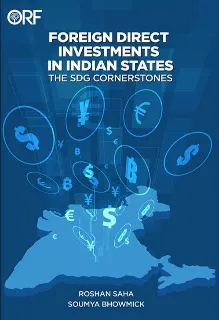There are varied political, social and economic factors across India’s states that determine their attractiveness to foreign direct investment (FDI). In the post-COVID-19 world, these same factors will be influenced by the availability of physical, social, natural, and human capital that the UN Sustainable Development Goals (SDGs) are aspiring for. Indeed, the COVID-19 pandemic is a critical juncture where countries across the globe are being forced to face their weaknesses in the global supply chains, which have increasingly come under China’s hegemony in recent years. While India’s flagship ‘Make in India’ policy is largely guided by an attempt to attract FDI and nurture value chains that begin and end in India, the prime minister’s clarion calls of ‘Atmanirbhar Bharat’a or ‘Vocal for Local’ must not be perceived as roadblocks to foreign investments and international trade. The ‘Atmanirbhar Bharat’[a] scheme was introduced to increase the resilience of the domestic economy to the elements of uncertainty posed by the COVID-19 pandemic. Through this scheme, the government aims to boost domestic production and make India a ‘self-reliant’ nation; funds worth INR 20 trillion have been disbursed for this purpose.
FDI is crucial for economic development, modernisation, and employment generation; it contributes to technology transfer, human capital formation, entrepreneurship, and efficiency of resource management. Espousing the spirit of ‘competitive federalism’, the Indian states have engaged in competition for FDI amongst themselves. States that have been successful in attracting higher FDI have enjoyed greater benefits from its positive spillovers.
This study maps the regional distribution of FDI inflows into India between 2005-06 and 2018-19. Data on FDI inflows are collected by the Reserve Bank of India (RBI) at its various regional offices, each of which often caters to more than one State or Union Territory. This dataset has been decomposed into its state-wise components by employing an appropriate statistical technique. Using this dataset estimated by the authors, the analysis outlines the subnational trends in FDI inflow. It reviews India’s policies on Special Economic Zones (SEZs), land, labour and industry to determine their role in governing the Ease of Doing Business environment, which in turn influences FDI inflow into the domestic economy.
Key Findings
- Developing nations in Asia, such as India, are some of the largest recipients of foreign investment in the world, and there is intense competition for FDI in the region. India recorded US$ 49
billion in FDI in 2019, a 16-percent increase from the previous year. This accounted for 80 percent of FDI flowing into South Asia in 2019.
- Analysis of sub-national FDI flows indicate the emergence of two categories of states: Those that have received uniform (i.e. low volatility) and high volumes of FDI between 2005-06 and 2018-19 are called ‘better performing’ states; another group that received low volumes of FDI, with high fluctuations (i.e. high volatility) in yearly inflows, are the ‘poor performing’ states.
- The ‘poor performing’ states in India with high FDI volatility are Bihar, Madhya Pradesh, Rajasthan, Jharkhand and Uttar Pradesh. The ‘better performing’ states with low FDI volatility are Delhi, Gujarat, Maharashtra, Tamil Nadu, Karnataka and Andhra Pradesh.
- Ease of Doing Business (EoDB) conditions should be improved to attract more FDI into the regions. For Indian states, this study estimates that a one-percent increase in the EoDB score
leads to a 6.32-percent increase in FDI inflow.
- Better performance on the SDGs parameters improves aspects of EoDB, and enables a congenial investment climate. Estimates for the Indian states suggest that a one-percent increase in SDG scores translates into a 0.80-percent increase in EoDB parameters and a 6.77-percent increase in FDI inflows.
- The ‘poor performing’ states must establish SEZs with favourable conditions, while the ‘better performing’ states should also focus on the holistic sustainability concerns in accordance with environmental, social and governance (ESG) considerations.
- Current literature suggests that FDI contributes to domestic capital formation. Competition for FDI among Indian states, employing the driving principles of SDGs, will not only ensure long-term economic growth, but also lead to equitable distribution of the gains from FDI.
Read the full report here.
The views expressed above belong to the author(s). ORF research and analyses now available on Telegram! Click here to access our curated content — blogs, longforms and interviews.

 PDF Download
PDF Download



 PREV
PREV



